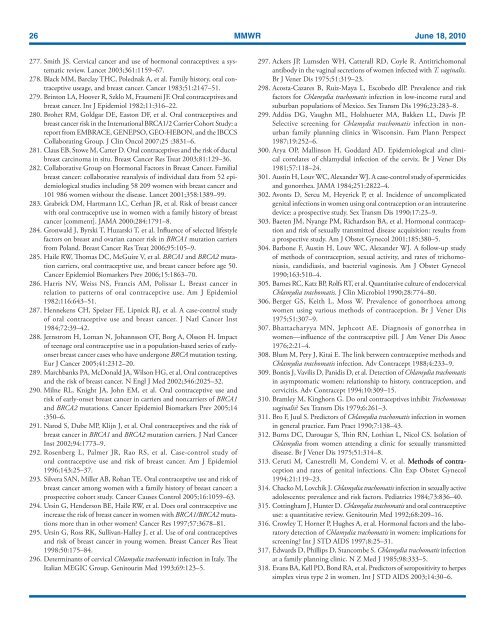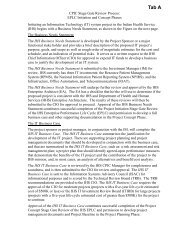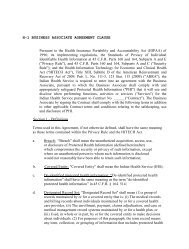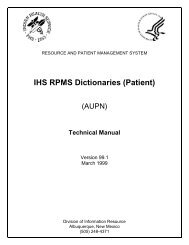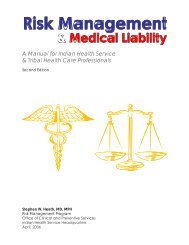CDC Article-US Medical Eligibility Criteria for Contraceptive Use, 2010
CDC Article-US Medical Eligibility Criteria for Contraceptive Use, 2010
CDC Article-US Medical Eligibility Criteria for Contraceptive Use, 2010
Create successful ePaper yourself
Turn your PDF publications into a flip-book with our unique Google optimized e-Paper software.
26 MMWR June 18, <strong>2010</strong><br />
277. Smith JS. Cervical cancer and use of hormonal conraceptives: a systematic<br />
review. Lancet 2003;361:1159–67.<br />
278. Black MM, Barclay THC, Polednak A, et al. Family history, oral contraceptive<br />
useage, and breast cancer. Cancer 1983;51:2147–51.<br />
279. Brinton LA, Hoover R, Szklo M, Fraumeni JF. Oral contraceptives and<br />
breast cancer. Int J Epidemiol 1982;11:316–22.<br />
280. Brohet RM, Goldgar DE, Easton DF, et al. Oral contraceptives and<br />
breast cancer risk in the International BRCA1/2 Carrier Cohort Study: a<br />
report from EMBRACE, GENEPSO, GEO-HEBON, and the IBCCS<br />
Collaborating Group. J Clin Oncol 2007;25 :3831–6.<br />
281. Claus EB, Stowe M, Carter D. Oral contraceptives and the risk of ductal<br />
breast carcinoma in situ. Breast Cancer Res Treat 2003;81:129–36.<br />
282. Collaborative Group on Hormonal Factors in Breast Cancer. Familial<br />
breast cancer: collaborative reanalysis of individual data from 52 epidemiological<br />
studies including 58 209 women with breast cancer and<br />
101 986 women without the disease. Lancet 2001;358:1389–99.<br />
283. Grabrick DM, Hartmann LC, Cerhan JR, et al. Risk of breast cancer<br />
with oral contraceptive use in women with a family history of breast<br />
cancer [comment]. JAMA 2000;284:1791–8.<br />
284. Gronwald J, Byrski T, Huzarski T, et al. Influence of selected lifestyle<br />
factors on breast and ovarian cancer risk in BRCA1 mutation carriers<br />
from Poland. Breast Cancer Res Treat 2006;95:105–9.<br />
285. Haile RW, Thomas DC, McGuire V, et al. BRCA1 and BRCA2 mutation<br />
carriers, oral contraceptive use, and breast cancer be<strong>for</strong>e age 50.<br />
Cancer Epidemiol Biomarkers Prev 2006;15:1863–70.<br />
286. Harris NV, Weiss NS, Francis AM, Polissar L. Breast cancer in<br />
relation to patterns of oral contraceptive use. Am J Epidemiol<br />
1982;116:643–51.<br />
287. Hennekens CH, Speizer FE, Lipnick RJ, et al. A case-control study<br />
of oral contraceptive use and breast cancer. J Natl Cancer Inst<br />
1984;72:39–42.<br />
288. Jernstrom H, Loman N, Johannsson OT, Borg A, Olsson H. Impact<br />
of teenage oral contraceptive use in a population-based series of earlyonset<br />
breast cancer cases who have undergone BRCA mutation testing.<br />
Eur J Cancer 2005;41:2312–20.<br />
289. Marchbanks PA, McDonald JA, Wilson HG, et al. Oral contraceptives<br />
and the risk of breast cancer. N Engl J Med 2002;346:2025–32.<br />
290. Milne RL, Knight JA, John EM, et al. Oral contraceptive use and<br />
risk of early-onset breast cancer in carriers and noncarriers of BRCA1<br />
and BRCA2 mutations. Cancer Epidemiol Biomarkers Prev 2005;14<br />
:350–6.<br />
291. Narod S, Dube MP, Klijn J, et al. Oral contraceptives and the risk of<br />
breast cancer in BRCA1 and BRCA2 mutation carriers. J Natl Cancer<br />
Inst 2002;94:1773–9.<br />
292. Rosenberg L, Palmer JR, Rao RS, et al. Case-control study of<br />
oral contraceptive use and risk of breast cancer. Am J Epidemiol<br />
1996;143:25–37.<br />
293. Silvera SAN, Miller AB, Rohan TE. Oral contraceptive use and risk of<br />
breast cancer among women with a family history of breast cancer: a<br />
prospective cohort study. Cancer Causes Control 2005;16:1059–63.<br />
294. Ursin G, Henderson BE, Haile RW, et al. Does oral contraceptive use<br />
increase the risk of breast cancer in women with BRCA1/BRCA2 mutations<br />
more than in other women? Cancer Res 1997;57:3678–81.<br />
295. Ursin G, Ross RK, Sullivan-Halley J, et al. <strong>Use</strong> of oral contraceptives<br />
and risk of breast cancer in young women. Breast Cancer Res Treat<br />
1998;50:175–84.<br />
296. Determinants of cervical Chlamydia trachomatis infection in Italy. The<br />
Italian MEGIC Group. Genitourin Med 1993;69:123–5.<br />
297. Ackers JP, Lumsden WH, Catterall RD, Coyle R. Antitrichomonal<br />
antibody in the vaginal secretions of women infected with T. vaginalis.<br />
Br J Vener Dis 1975;51:319–23.<br />
298. Acosta-Cazares B, Ruiz-Maya L, Escobedo dlP. Prevalence and risk<br />
factors <strong>for</strong> Chlamydia trachomatis infection in low-income rural and<br />
suburban populations of Mexico. Sex Transm Dis 1996;23:283–8.<br />
299. Addiss DG, Vaughn ML, Holzhueter MA, Bakken LL, Davis JP.<br />
Selective screening <strong>for</strong> Chlamydia trachomatis infection in nonurban<br />
family planning clinics in Wisconsin. Fam Plann Perspect<br />
1987;19:252–6.<br />
300. Arya OP, Mallinson H, Goddard AD. Epidemiological and clinical<br />
correlates of chlamydial infection of the cervix. Br J Vener Dis<br />
1981;57:118–24.<br />
301. Austin H, Louv WC, Alexander WJ. A case-control study of spermicides<br />
and gonorrhea. JAMA 1984;251:2822–4.<br />
302. Avonts D, Sercu M, Heyerick P, et al. Incidence of uncomplicated<br />
genital infections in women using oral contraception or an intrauterine<br />
device: a prospective study. Sex Transm Dis 1990;17:23–9.<br />
303. Baeten JM, Nyange PM, Richardson BA, et al. Hormonal contraception<br />
and risk of sexually transmitted disease acquisition: results from<br />
a prospective study. Am J Obstet Gynecol 2001;185:380–5.<br />
304. Barbone F, Austin H, Louv WC, Alexander WJ. A follow-up study<br />
of methods of contraception, sexual activity, and rates of trichomoniasis,<br />
candidiasis, and bacterial vaginosis. Am J Obstet Gynecol<br />
1990;163:510–4.<br />
305. Barnes RC, Katz BP, Rolfs RT, et al. Quantitative culture of endocervical<br />
Chlamydia trachomatis. J Clin Microbiol 1990;28:774–80.<br />
306. Berger GS, Keith L, Moss W. Prevalence of gonorrhoea among<br />
women using various methods of contraception. Br J Vener Dis<br />
1975;51:307–9.<br />
307. Bhattacharyya MN, Jephcott AE. Diagnosis of gonorrhea in<br />
women—influence of the contraceptive pill. J Am Vener Dis Assoc<br />
1976;2:21–4.<br />
308. Blum M, Pery J, Kitai E. The link between contraceptive methods and<br />
Chlamydia trachomatis infection. Adv Contracept 1988;4:233–9.<br />
309. Bontis J, Vavilis D, Panidis D, et al. Detection of Chlamydia trachomatis<br />
in asymptomatic women: relationship to history, contraception, and<br />
cervicitis. Adv Contracept 1994;10:309–15.<br />
310. Bramley M, Kinghorn G. Do oral contraceptives inhibit Trichomonas<br />
vaginalis? Sex Transm Dis 1979;6:261–3.<br />
311. Bro F, Juul S. Predictors of Chlamydia trachomatis infection in women<br />
in general practice. Fam Pract 1990;7:138–43.<br />
312. Burns DC, Darougar S, Thin RN, Lothian L, Nicol CS. Isolation of<br />
Chlamydia from women attending a clinic <strong>for</strong> sexually transmitted<br />
disease. Br J Vener Dis 1975;51:314–8.<br />
313. Ceruti M, Canestrelli M, Condemi V, et al. Methods of contraception<br />
and rates of genital infections. Clin Exp Obstet Gynecol<br />
1994;21:119–23.<br />
314. Chacko M, Lovchik J. Chlamydia trachomatis infection in sexually active<br />
adolescents: prevalence and risk factors. Pediatrics 1984;73:836–40.<br />
315. Cottingham J, Hunter D. Chlamydia trachomatis and oral contraceptive<br />
use: a quantitative review. Genitourin Med 1992;68:209–16.<br />
316. Crowley T, Horner P, Hughes A, et al. Hormonal factors and the laboratory<br />
detection of Chlamydia trachomatis in women: implications <strong>for</strong><br />
screening? Int J STD AIDS 1997;8:25–31.<br />
317. Edwards D, Phillips D, Stancombe S. Chlamydia trachomatis infection<br />
at a family planning clinic. N Z Med J 1985;98:333–5.<br />
318. Evans BA, Kell PD, Bond RA, et al. Predictors of seropositivity to herpes<br />
simplex virus type 2 in women. Int J STD AIDS 2003;14:30–6.


